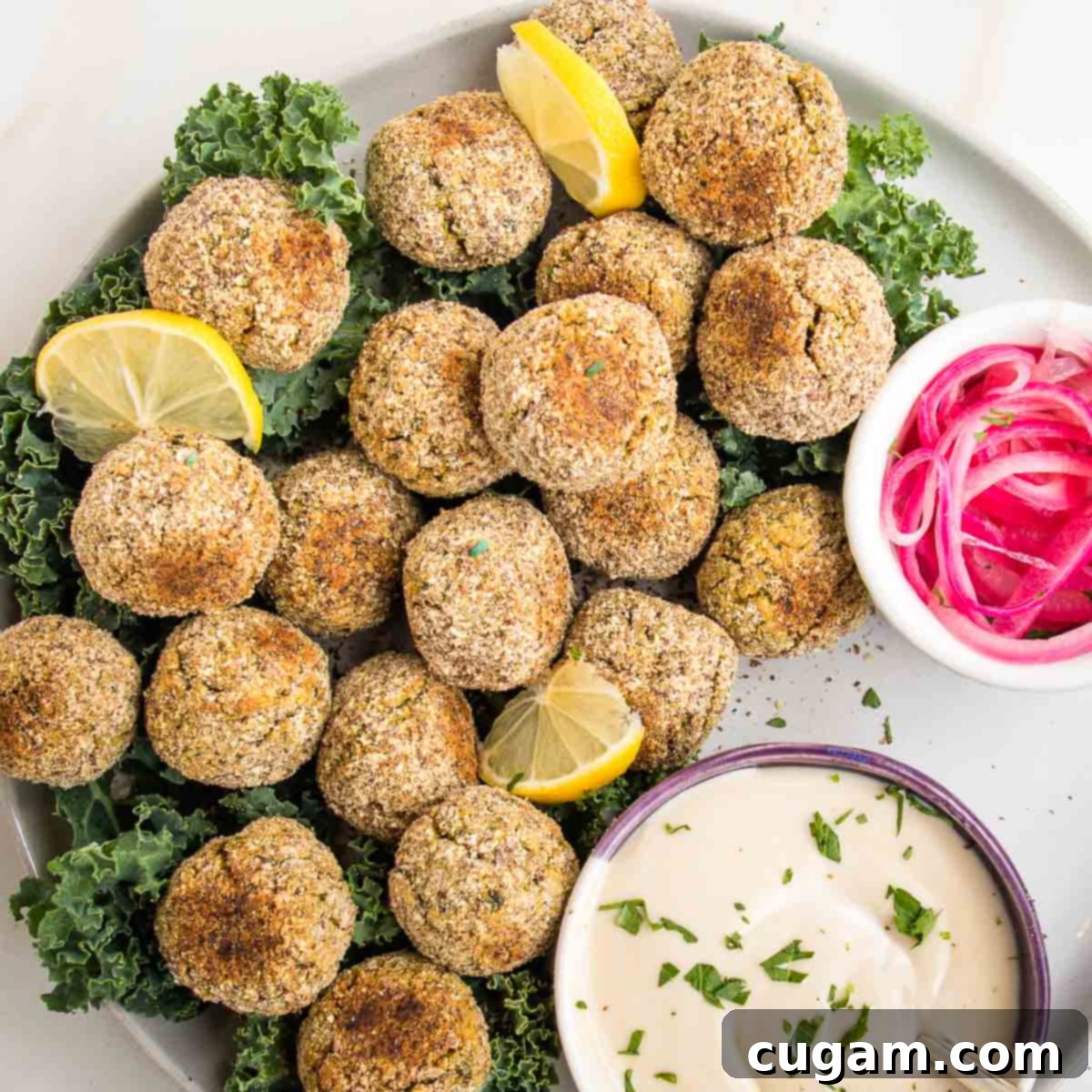Healthy Oven Baked Falafel: Crispy, Flavorful, and Vegan Perfection
Say goodbye to greasy fried falafel and hello to this incredibly delicious and healthy oven-baked version! These homemade falafel balls, paired with tangy pickled onions and creamy tahini sauce, are surprisingly easy to make and boast an authentic, satisfying flavor without any of the discomfort. Perfect for a nutritious and satisfying vegan meal, serve them on a vibrant Mediterranean plate alongside tofu shawarma, dairy-free tzatziki, hummus, baba ganoush, and Israeli salad. Alternatively, tuck them into crisp lettuce wraps or warm pita bread for a portable and delightful culinary experience.
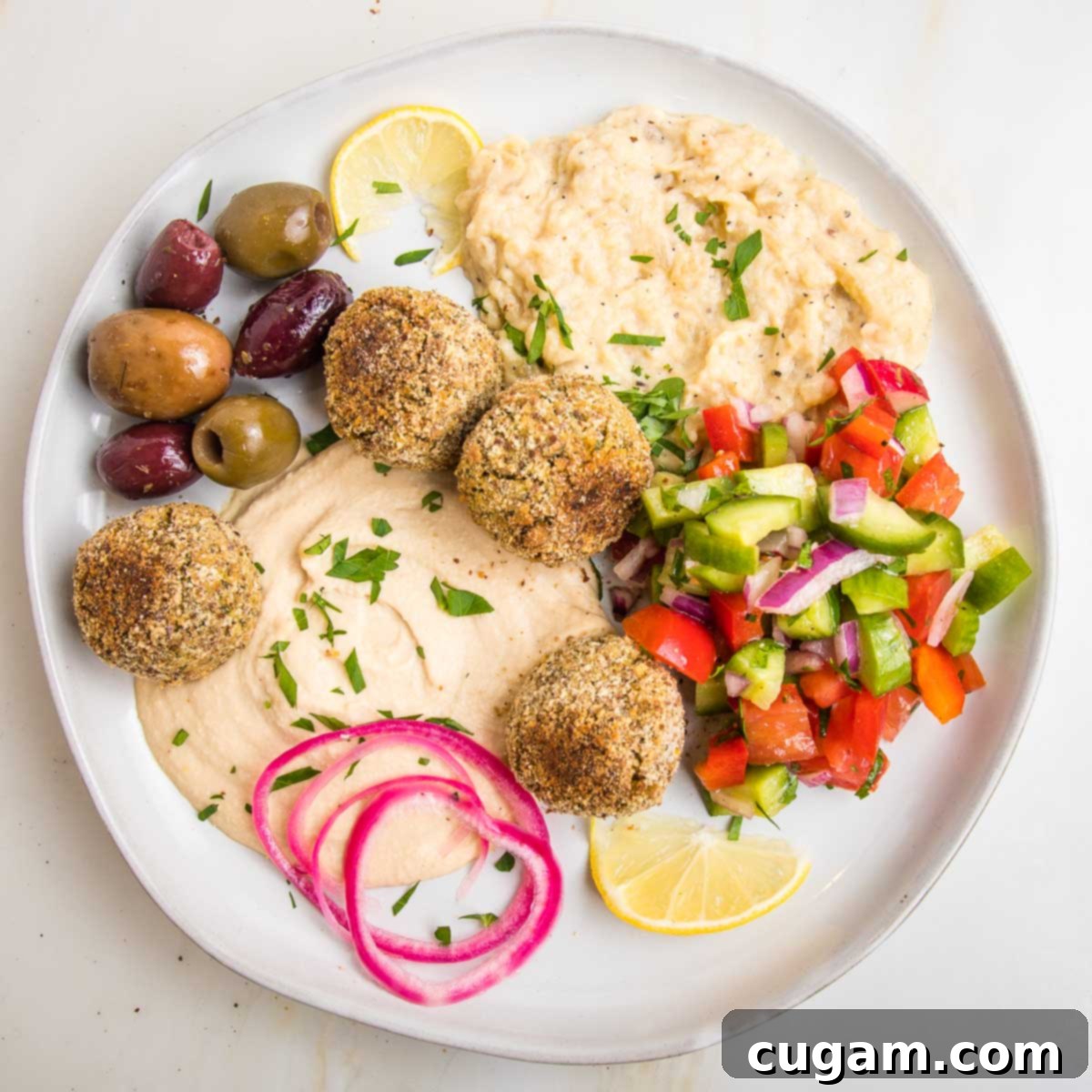
This post has been updated from the original that was posted in February 2018, bringing you even more tips and refined deliciousness!
Who doesn’t love falafel? It’s a universally adored dish, and if you’re like me, you’ve probably craved its savory goodness more times than you can count. The good news? My healthy oven-baked falafel recipe lets you indulge in this Middle Eastern delight anytime you wish, without the guilt or the heavy feeling of traditional fried versions. We’re talking authentic falafel taste, made with a smart blend of fresh and pantry staples, ensuring every bite is pure perfection.
My ideal Mediterranean plate is a symphony of flavors and textures: fluffy chickpea falafel, creamy roasted cauliflower hummus, a refreshing chopped Israeli salad, luscious homemade baba ganoush, vibrant pickled onions, light gluten-free tabbouleh, and a handful of olives. This healthy falafel plate is my go-to for a truly satisfying and nourishing meal that I could happily eat every single day.
For those who prefer a different presentation, my husband often enjoys his falafel tucked into warm pita bread, loaded with all the fixings and a generous extra drizzle of tahini sauce. And when we’re looking for a lighter option, we often meet in the middle, using crisp butter lettuce or crunchy romaine leaves as a fresh, low-carb wrapper for these glorious oven-baked falafel.
Essential Falafel Ingredients and Smart Substitutions
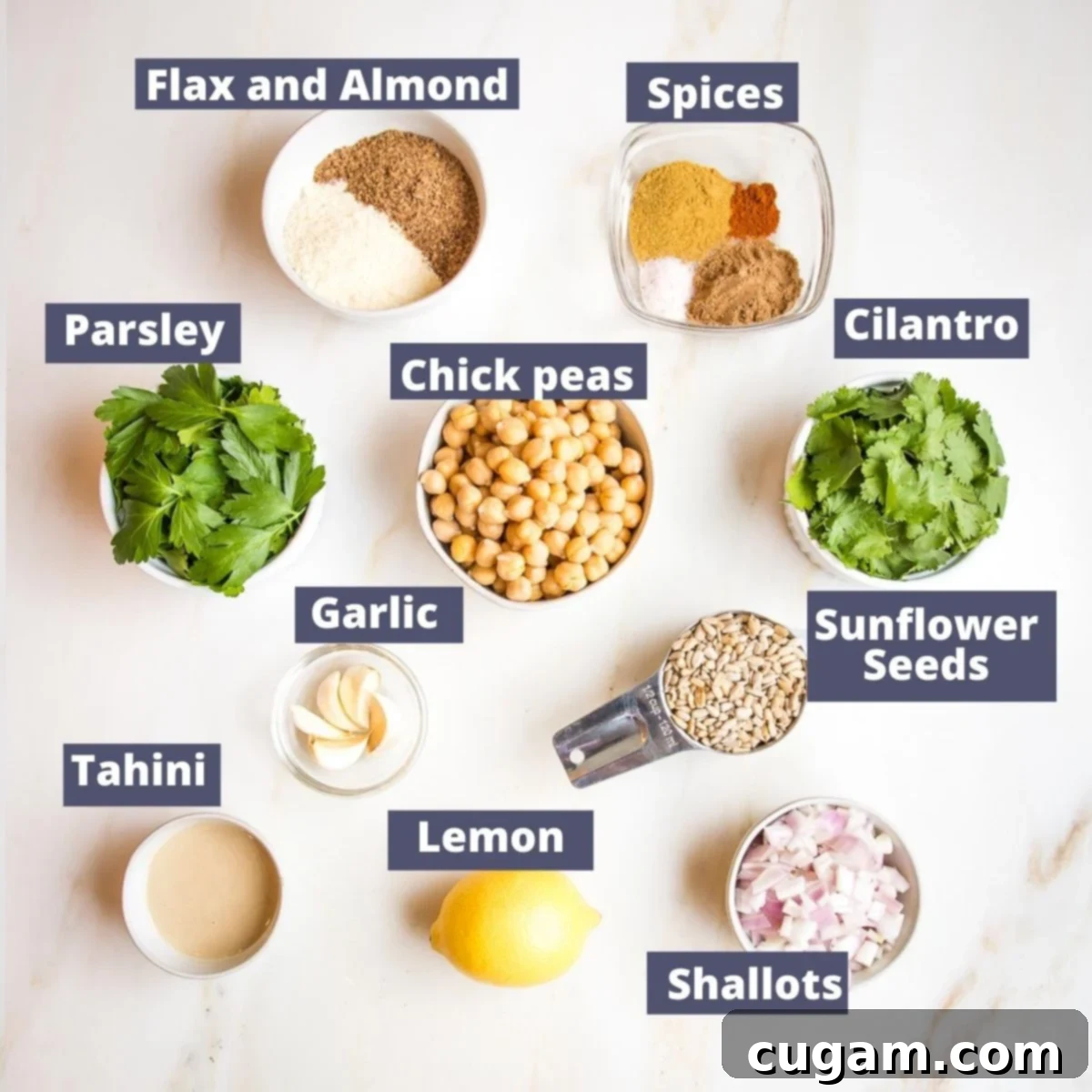
Crafting the perfect falafel starts with quality ingredients. Here’s a breakdown of what you’ll need and how you can adapt the recipe to your pantry or dietary needs:
- CHICKPEAS: The heart of falafel! While making them from dried beans yields a firmer texture, canned chickpeas are perfectly acceptable for convenience. Just be sure to rinse them thoroughly to remove excess sodium. Chickpeas are nutritional powerhouses, packed with fiber and protein, making this a truly satisfying plant-based meal. They contribute to gut health, provide sustained energy, and are a fantastic foundation for any vegetarian or vegan diet.
- PARSLEY: Fresh parsley is a non-negotiable for authentic falafel flavor. Whether you opt for curly or flat-leaf, its vibrant taste and dense nutritional profile will shine through. Parsley is hailed as one of the most nutrient-rich leafy greens, loaded with Vitamins A, C, and K. Beyond that, it’s a potent source of antioxidants, supports strong bone health, boasts antibacterial properties, and may even help in the fight against certain cancers.
- CILANTRO: A personal favorite herb that adds another layer of fresh, aromatic complexity. If cilantro isn’t your cup of tea (some find it tastes like soap!), simply increase the amount of parsley to compensate. You’ll still achieve a wonderfully herbaceous flavor.
- SUNFLOWER SEEDS: These tiny seeds contribute a subtle nutty flavor, a boost of healthy fats and protein, and essential bulk to the falafel mixture. Feel free to substitute with any other nut or seed you prefer, such as sesame seeds, pumpkin seeds, or even a small amount of walnuts, for similar textural and flavor results.
- GARLIC: A fundamental flavor enhancer in Mediterranean cuisine. Beyond its pungent taste, garlic offers anti-inflammatory benefits, bolsters the immune system, and can help regulate blood sugar. If fresh cloves aren’t available, use garlic powder – but avoid garlic salt, as it will alter the seasoning balance.
- SHALLOTS: Milder and sweeter than red onion, shallots provide a delicate onion flavor. Red onions make an excellent substitute if shallots are hard to find. Green onions (scallions) would also work well, offering a slightly fresher, milder note.
- LEMON: Both the zest and the juice are crucial here, providing bright, fresh acidity that balances the richness of the chickpeas and tahini. If fresh lemons aren’t on hand, 2-3 tablespoons of bottled lemon juice will do. Lime juice can also be used as an alternative, perhaps needing 1-2 limes depending on their size and juiciness.
- TAHINI: For the best results, use a drippy, well-mixed tahini in this recipe. Tahini imparts a characteristic nutty depth, along with healthy fats, calcium, manganese, Vitamin B6, and thiamine. If substituting with another nut or seed butter, ensure it’s thoroughly stirred and has a pourable consistency. The quality of your tahini significantly impacts the final taste and texture.
- SPICES: Cumin and coriander are the star spices, providing the warm, earthy, and distinctly Middle Eastern flavor profile that defines falafel. These two spices are non-negotiable for an authentic taste.
- COATING MIXTURE: A combination of almond meal and ground flaxseed creates a wonderful crispy exterior when baked, mimicking the texture of fried falafel. For those with nut allergies, simply use all ground flaxseed. This coating is key to achieving that desirable crispness without the need for deep frying.
Why This is The BEST Healthy Oven Baked Falafel Recipe
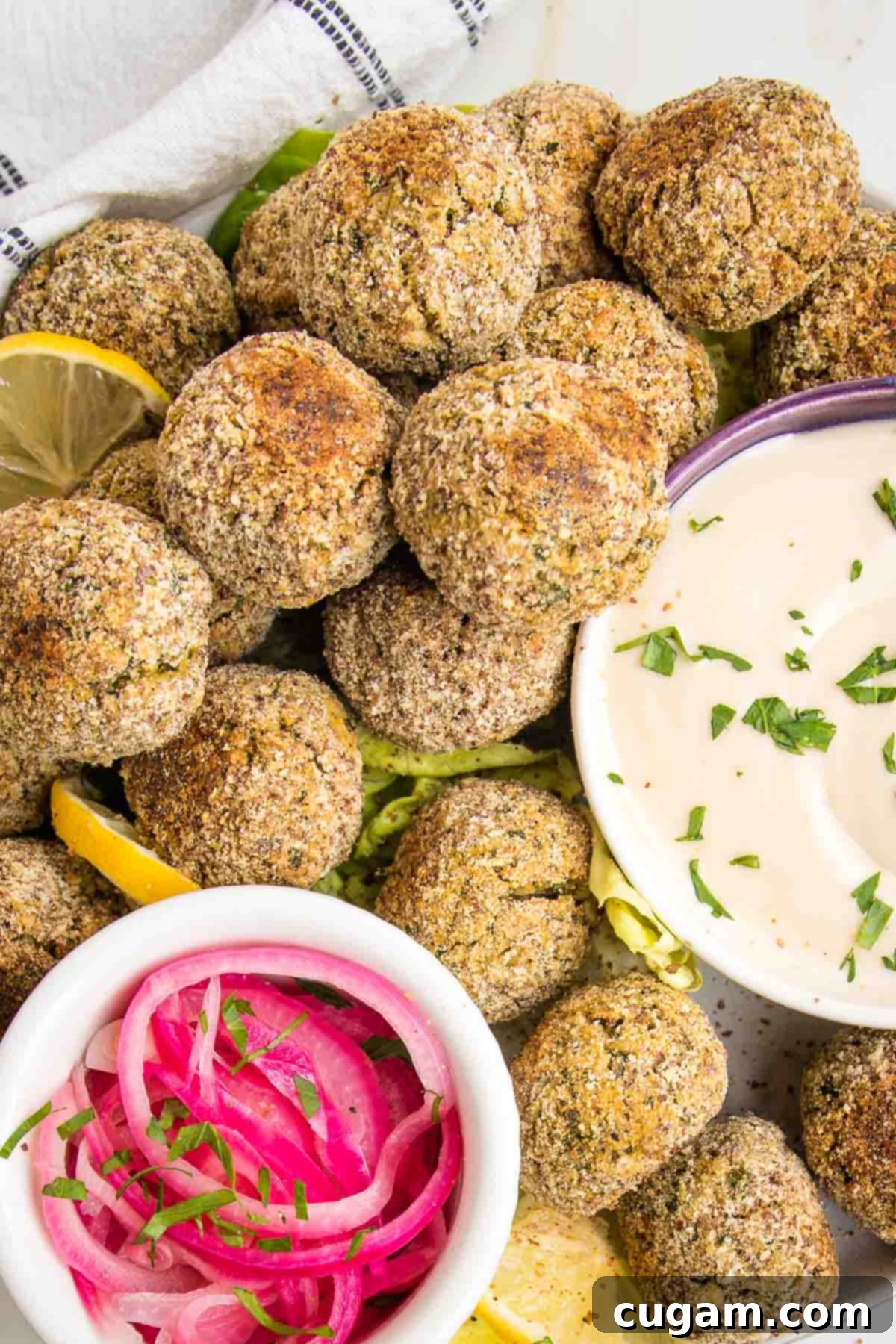
This isn’t just another falafel recipe; it’s the *best* for several compelling reasons:
- BAKED, NOT FRIED: The most significant advantage! By baking, we eliminate excessive oil and grease, resulting in a lighter, healthier falafel without compromising on flavor or texture. Plus, you won’t need to stand over a hot stove, making cleanup a breeze and your kitchen less messy.
- ABSOLUTELY DELISH: Our falafel bursts with incredible flavor thanks to a generous blend of fresh herbs like parsley and cilantro, aromatic garlic, and authentic Middle Eastern spices. Each bite offers a harmonious balance of earthy, zesty, and savory notes that will transport your taste buds.
- EFFORTLESSLY EASY TO MAKE: With the help of your food processor, most of the heavy lifting is done in minutes. Simply pulse the ingredients, form the balls, and pop them into the oven. It’s a remarkably straightforward recipe, even for novice cooks, proving that healthy eating doesn’t have to be complicated.
- INCREDIBLY VERSATILE: These falafel are a blank canvas for culinary creativity. They can be enjoyed in so many ways – as a protein-rich addition to salads, nestled in wraps, served in nourishing bowls, or classic pita sandwiches. This vegan protein option seamlessly fits into any meal plan.
- DEEPLY SATISFYING: Thanks to the high fiber content of chickpeas and the plant-based protein, these falafel will keep you feeling full and energized for hours without the heavy, sluggish feeling often associated with fried foods. It’s a meal that truly nourishes both body and soul.
How to Make Healthy Baked Falafel with Canned Chickpeas: A Step-by-Step Guide
Creating these delightful falafel is a straightforward process. Before you begin, preheat your oven to a blazing 450°F (230°C) to ensure a perfectly crispy exterior. Also, prepare a large rimmed baking sheet by lining it with unbleached parchment paper – this prevents sticking and aids in easy cleanup.
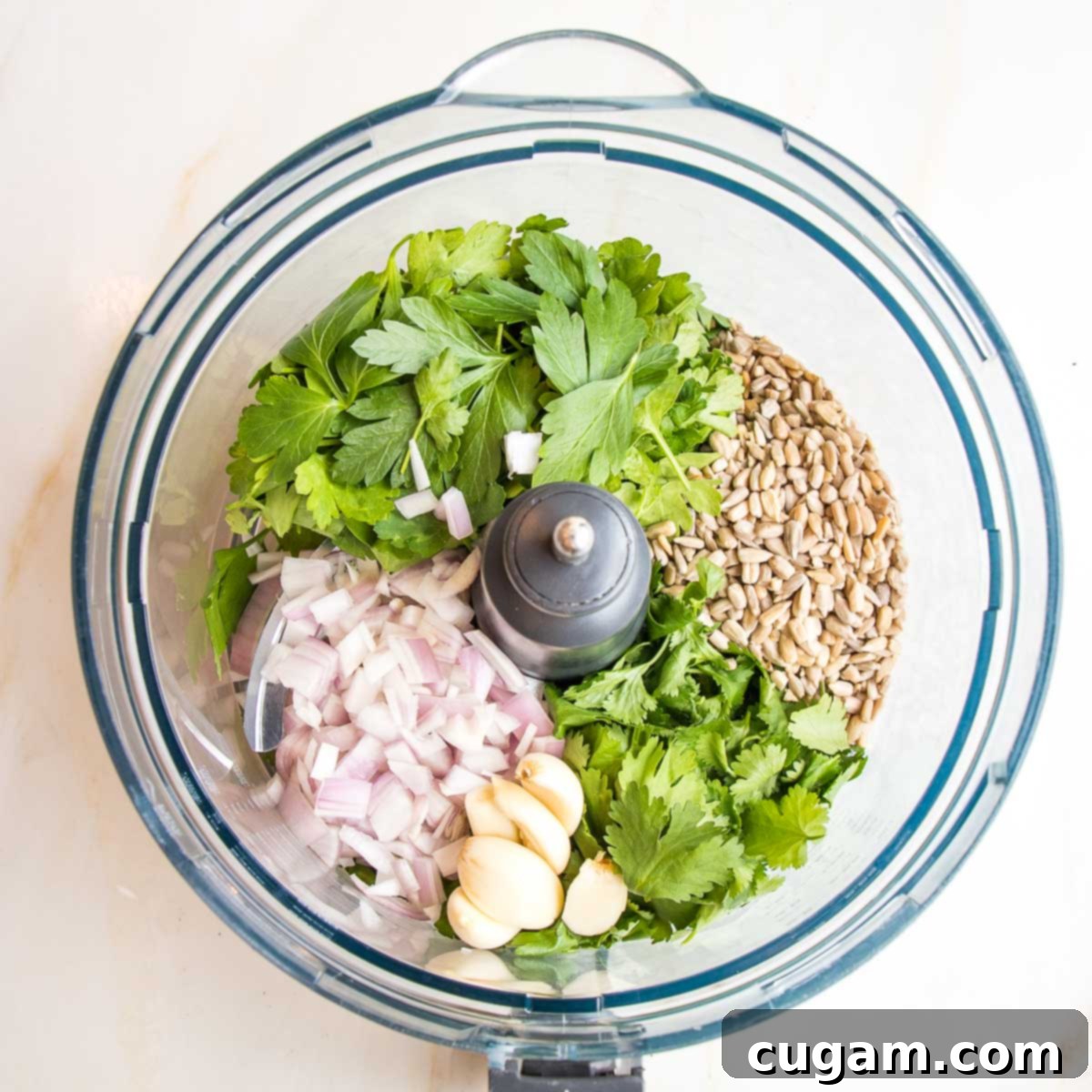
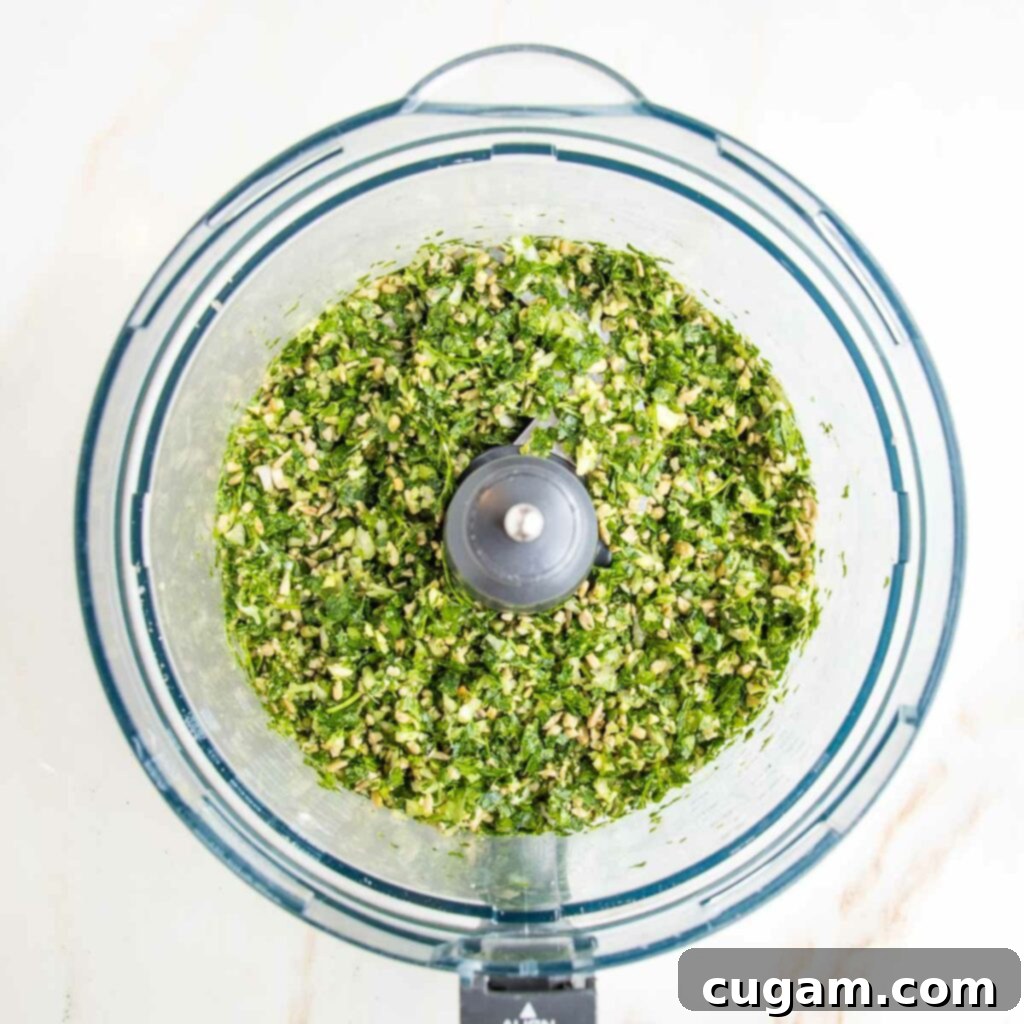
First, gather your fresh ingredients: place the fresh cilantro, parsley, roughly chopped shallot, garlic cloves, and sunflower seeds into the bowl of your food processor. There’s no need for meticulous pre-chopping of the herbs, but do make sure to remove any woody stems. Process these ingredients until everything is uniformly chopped into very tiny pieces, ensuring no large chunks of garlic or sunflower seeds remain. This fine consistency is crucial for the falafel to hold together properly.
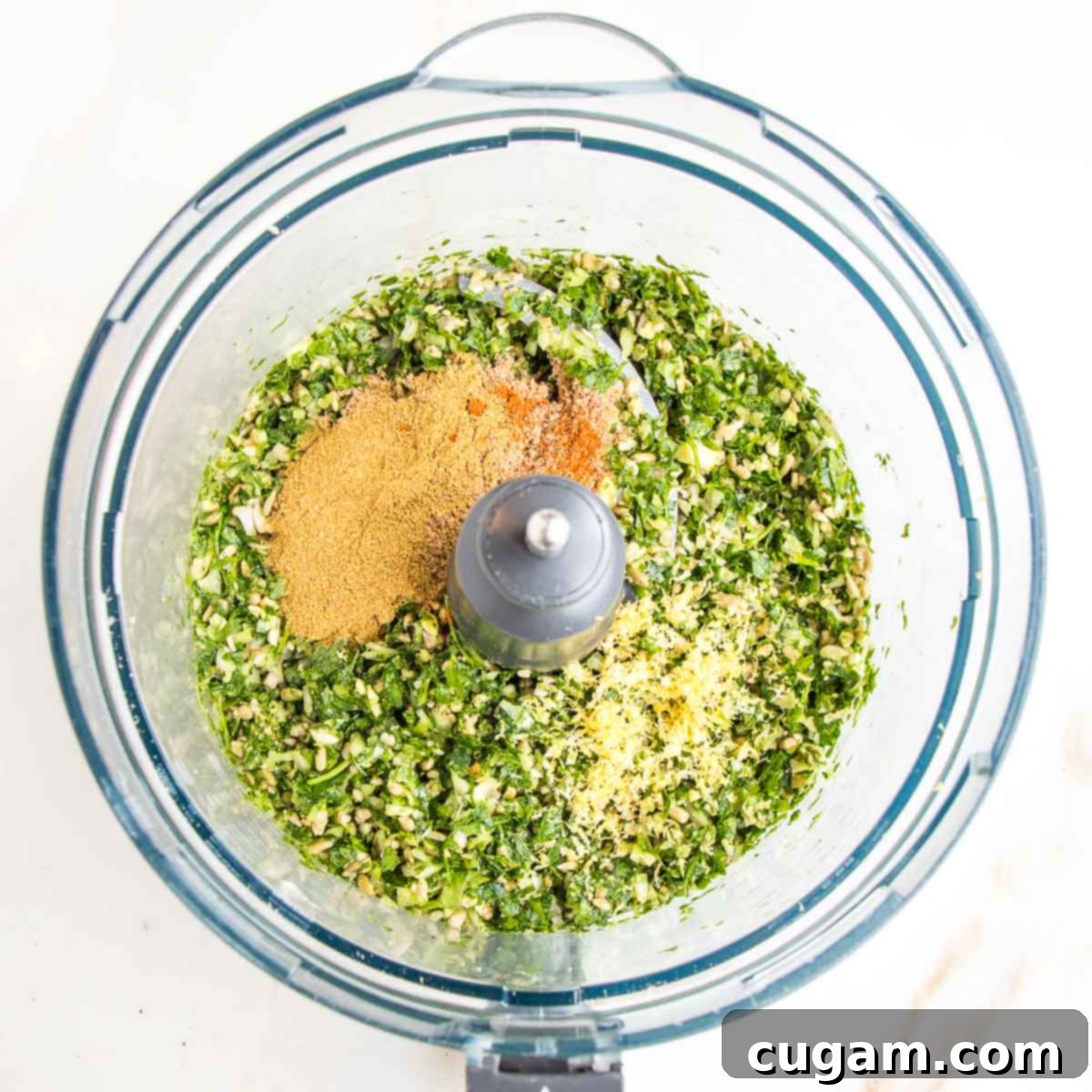
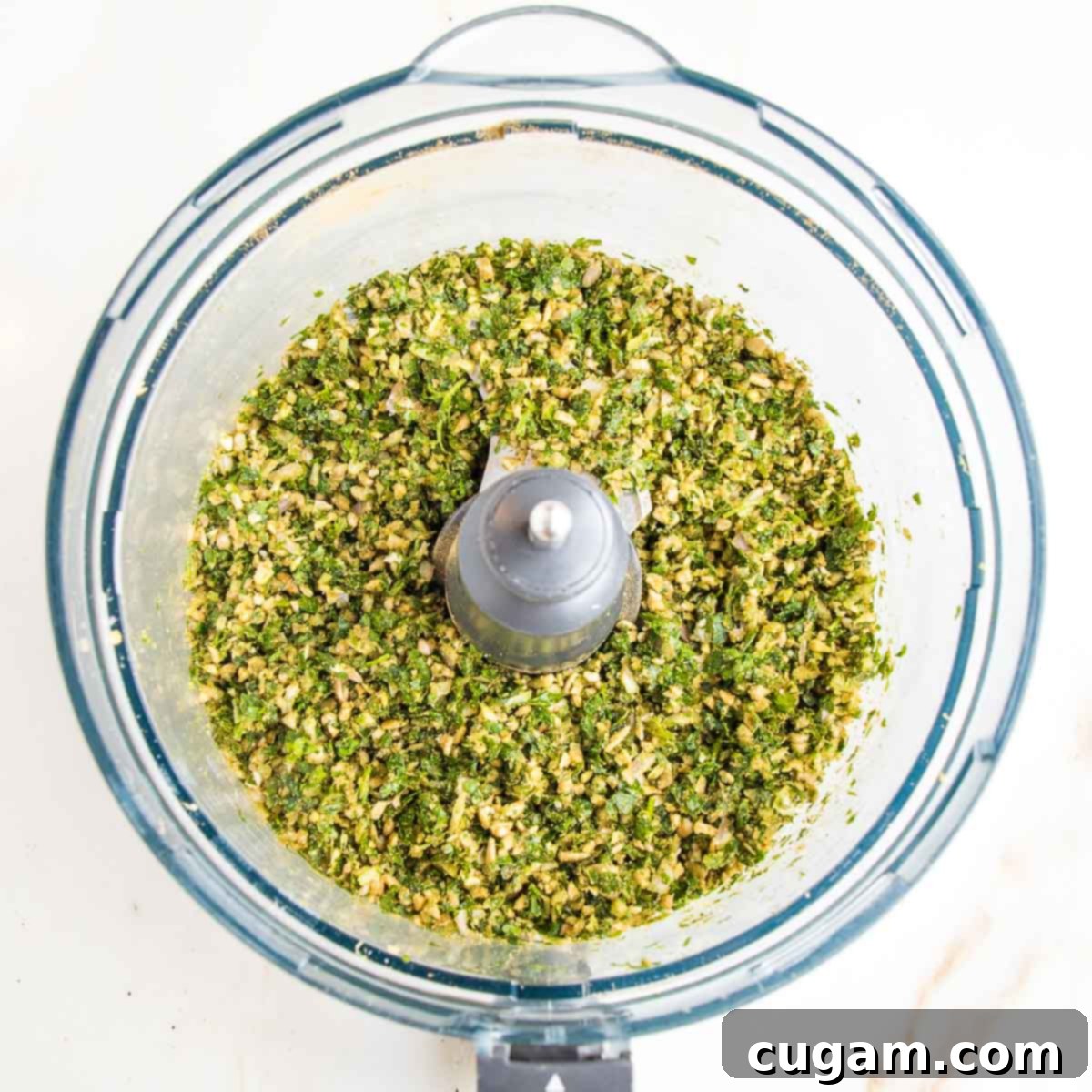
Next, sprinkle the cumin, coriander, sea salt, and a pinch of cayenne pepper (adjust to your spice preference) onto the herb mixture in the food processor. Use a microplane to zest the lemon directly over the bowl, capturing all those fragrant oils. Pulse again until these new additions are thoroughly mixed into the rest of the ingredients, creating a deeply aromatic base.
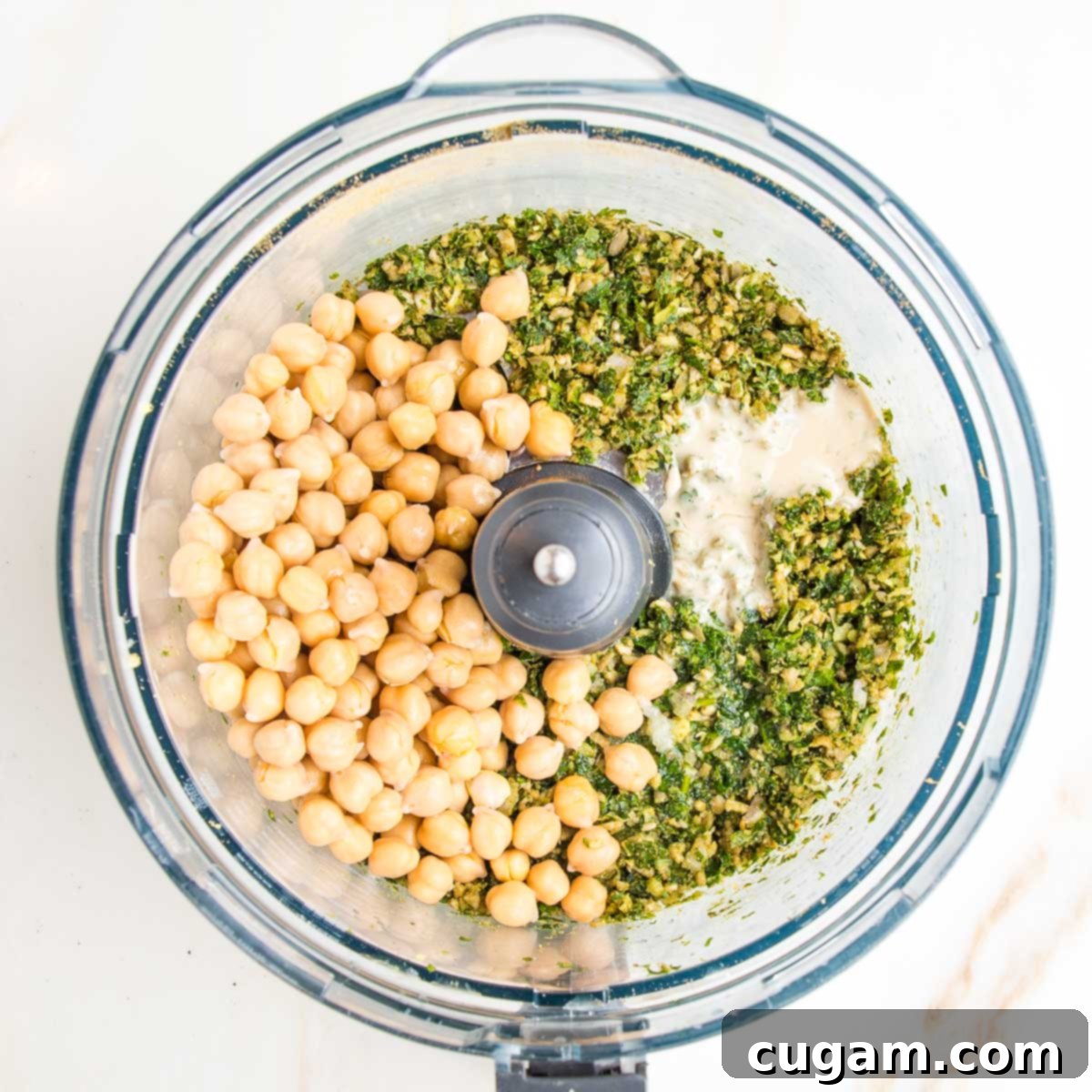
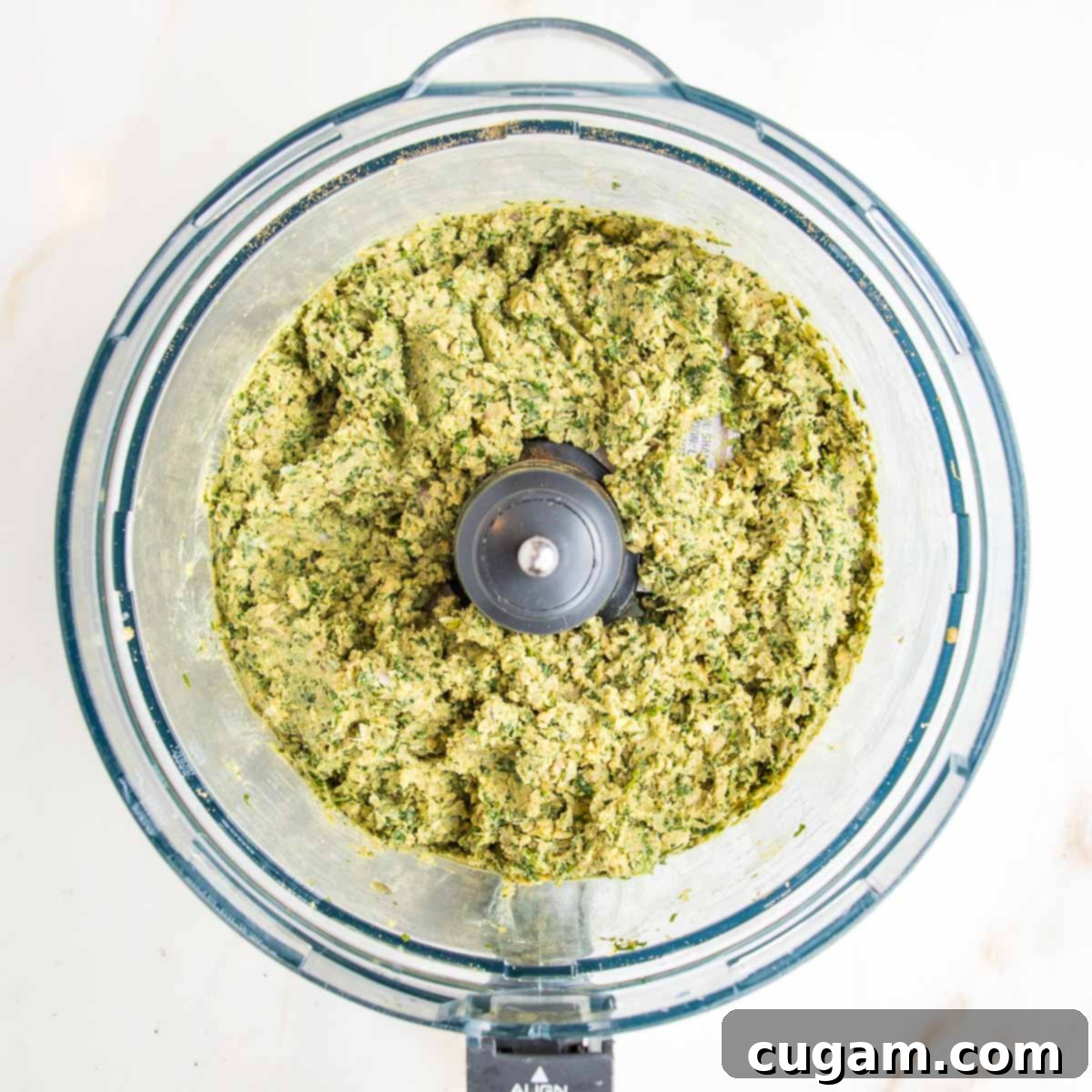
Now, it’s time for the final blending stage. Using a lemon juicer, extract the juice from the zested lemon and add it to the food processor bowl. Then, incorporate the rinsed chickpeas and the drippy tahini. Pulse the mixture until the chickpeas are thoroughly incorporated, forming a coarse paste. It’s perfectly fine to have some larger pieces, but avoid whole chickpeas. The goal is a texture that’s cohesive enough to hold its shape.
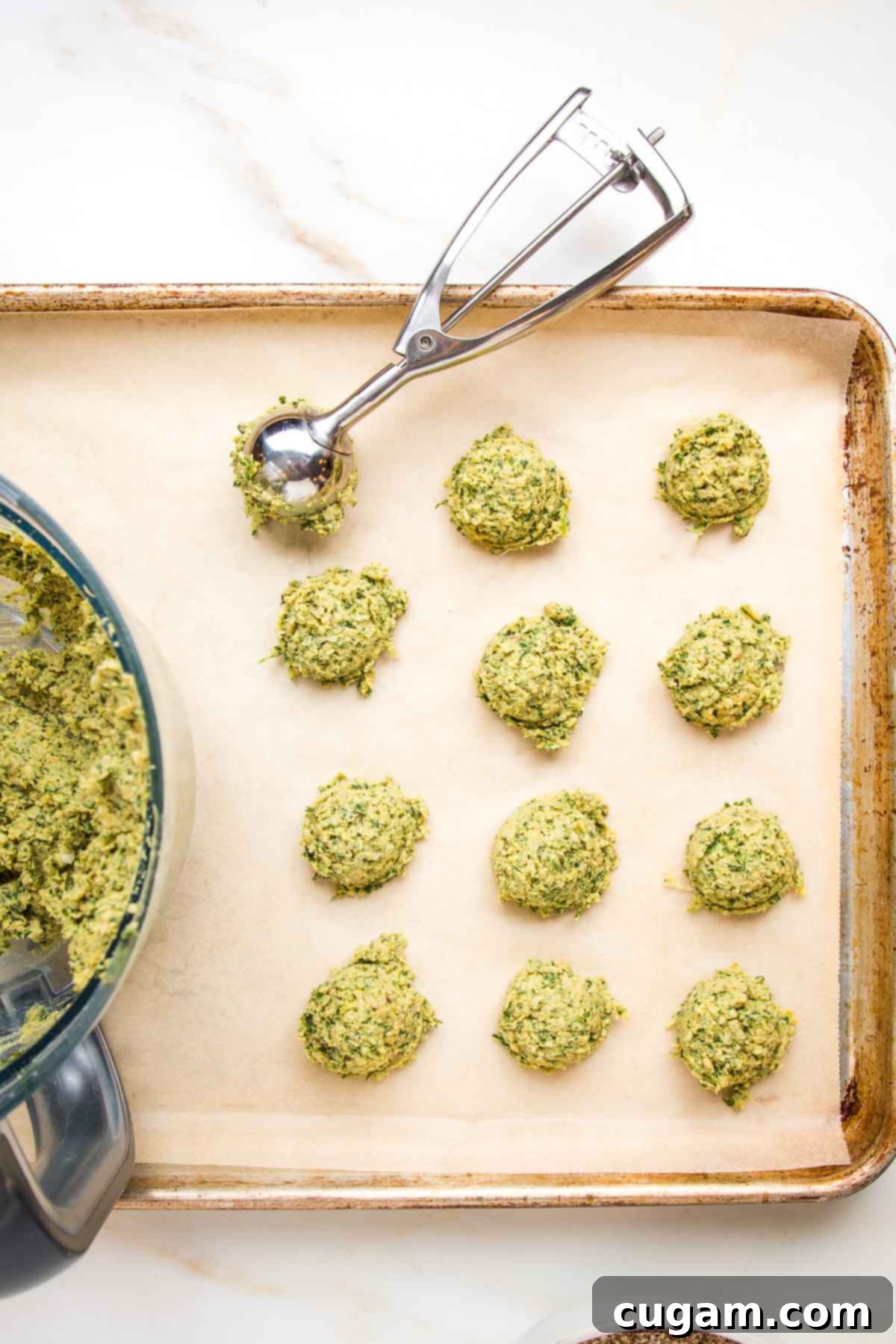
Using a small cookie scoop makes portioning out the falafel mixture onto your prepared baking pan incredibly easy and uniform. You should aim for about 20 falafel balls. If you don’t have a scoop, simply use two tablespoons – one to scoop and the other to gently push the mixture onto the tray. This method works just as well!
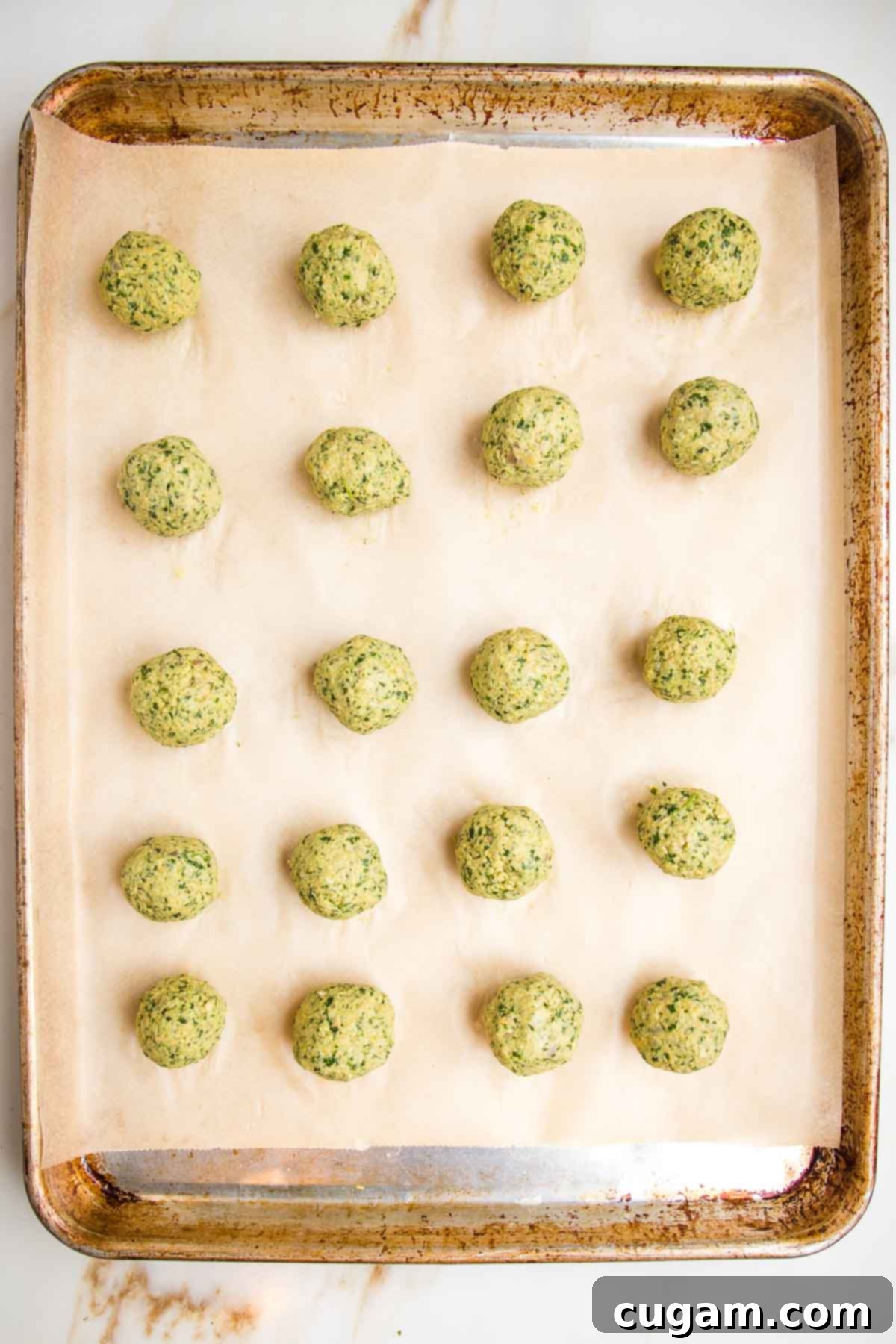
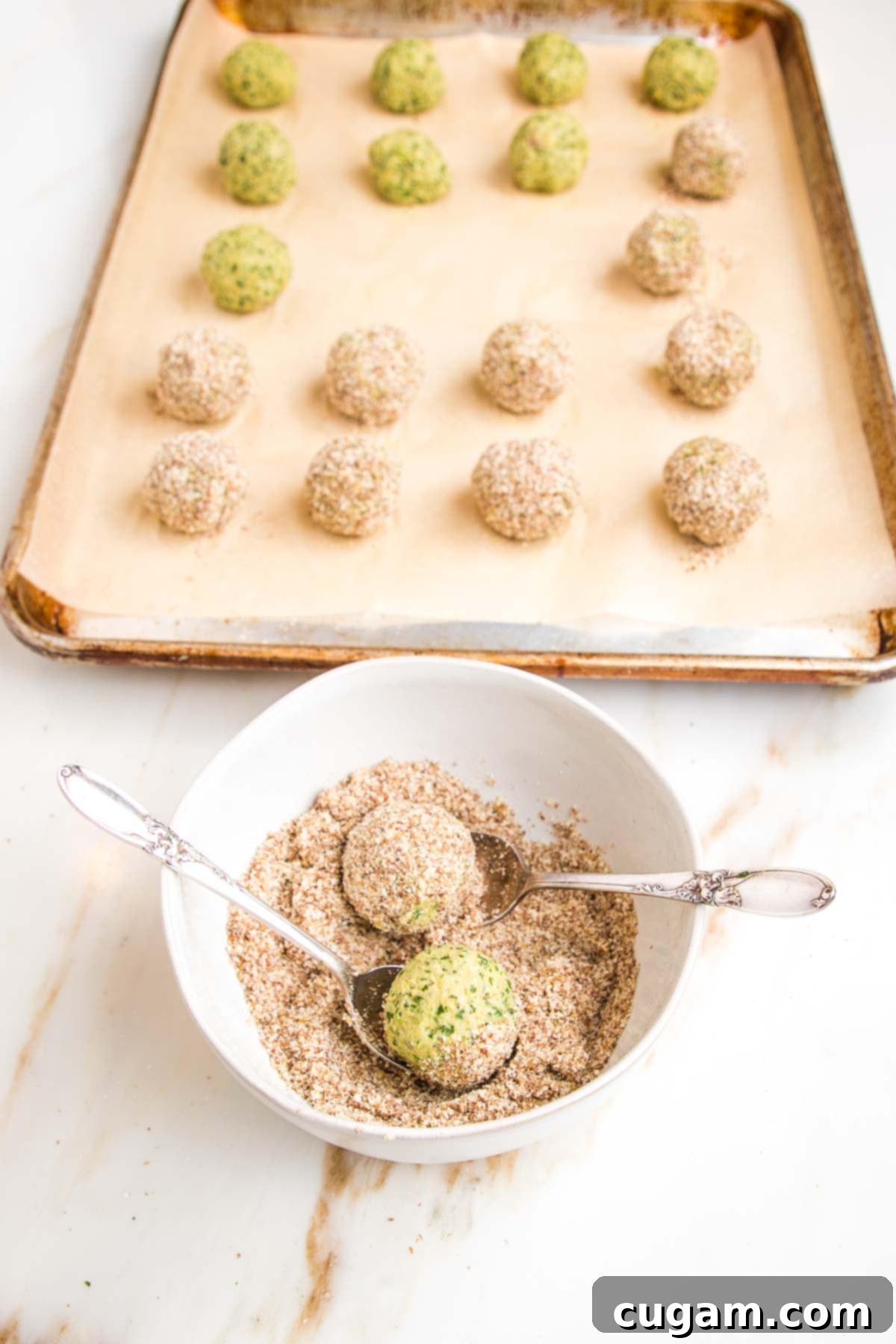
Now, wet your hands slightly and take each falafel portion, rolling it into a smooth, golf-ball-sized sphere. If you prefer a flatter, mini-burger-like falafel, you can also form them into small patties. In a shallow bowl, combine the almond meal and ground flaxseed to create your crispy coating. Gently roll each falafel ball in this mixture until it’s evenly coated, then return it to the prepared baking tray, ensuring there’s a little space between each one for even cooking. This coating is what gives our baked falafel that irresistible crunch!
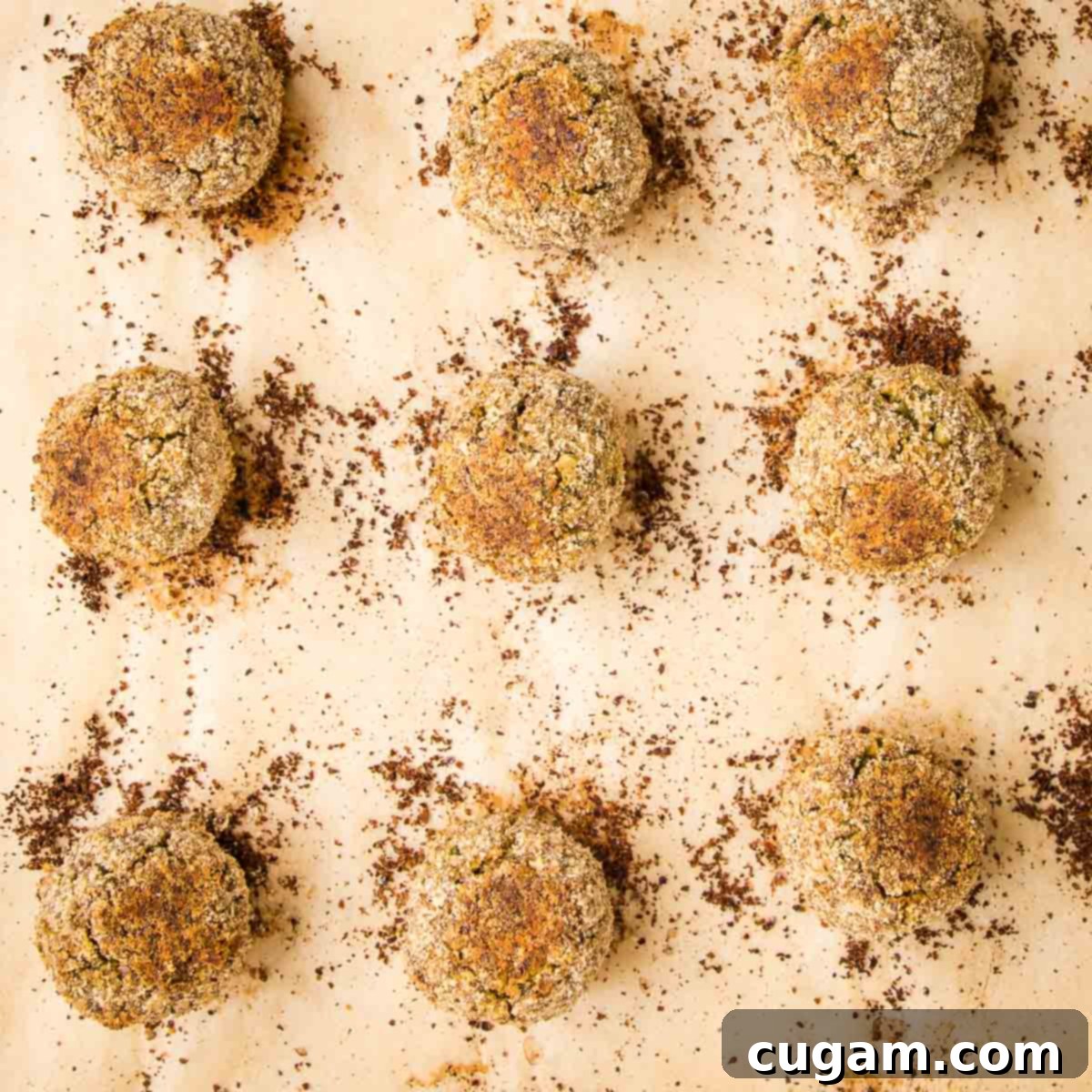
Bake the falafel in your preheated 450°F (230°C) oven for 15 minutes. After this initial bake, carefully roll the falafel balls over to the other side and continue baking for an additional 10 minutes, or until they are beautifully golden brown and crisp on the outside, yet tender and flavorful on the inside. This two-stage baking ensures maximum crispness! It’s perfectly normal if some of the coating crumbles onto the parchment paper – these extra crispy bits can be discarded with the paper or sprinkled onto your falafel salad plate for added texture and flavor.
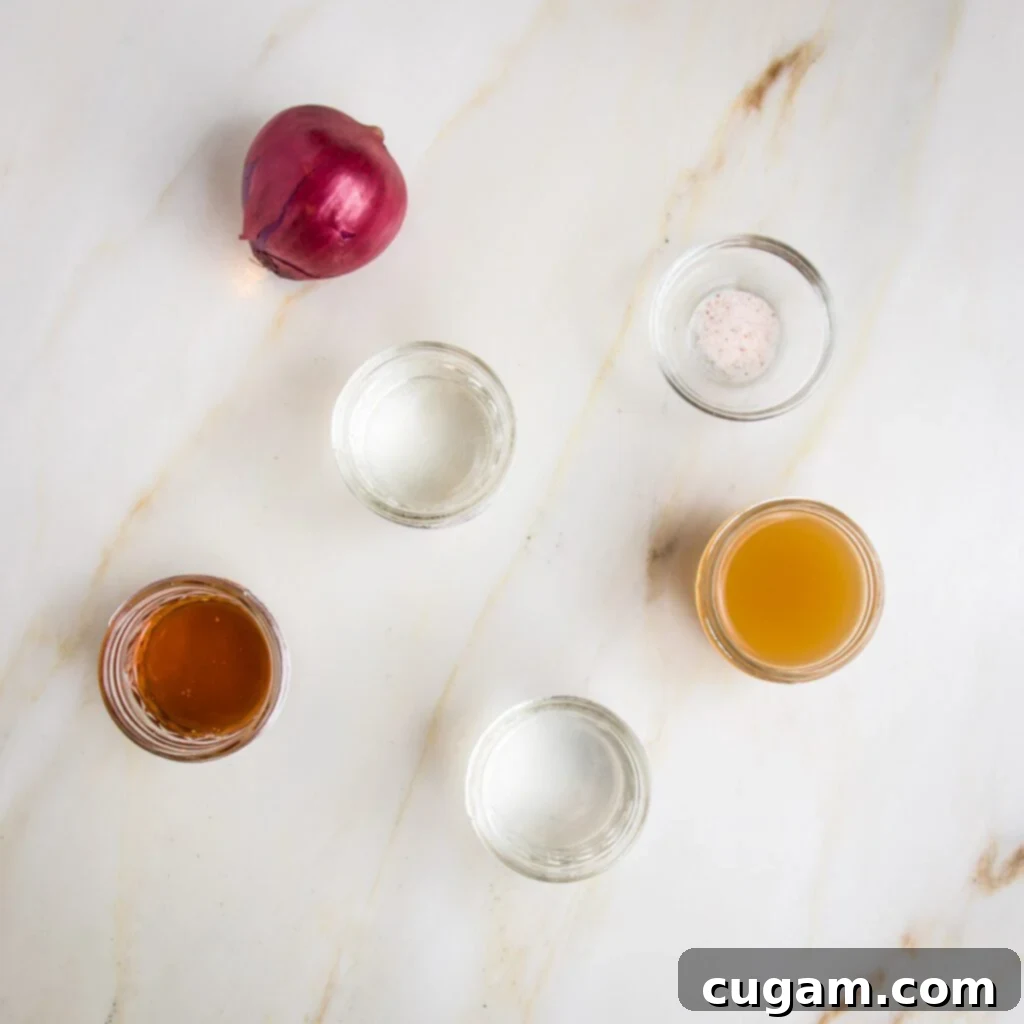
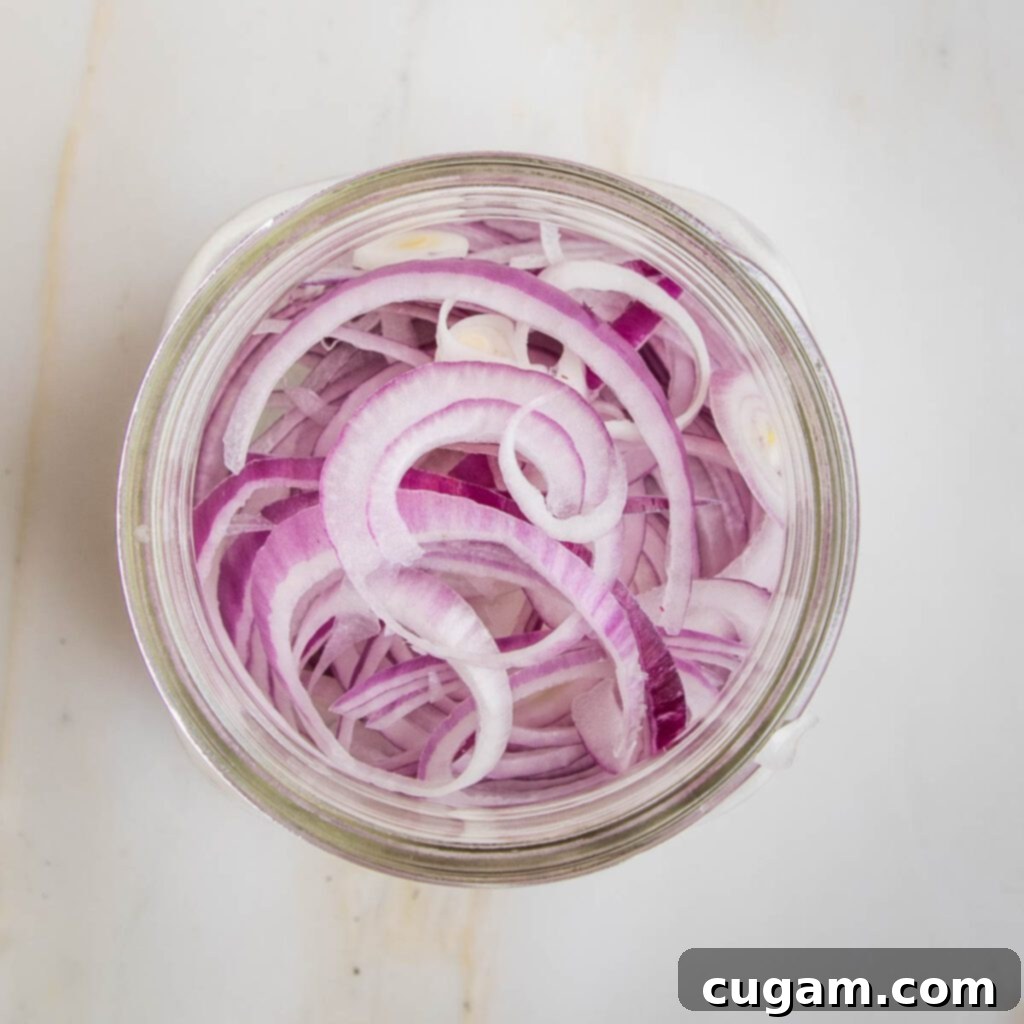
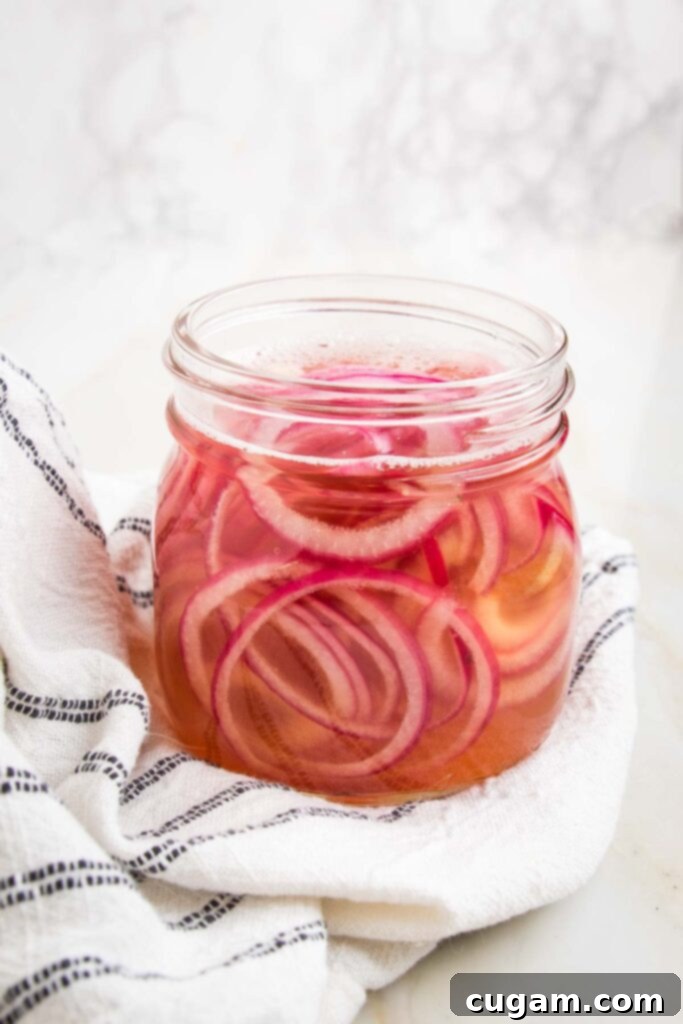
While your falafel is baking, you have the perfect window to prepare two essential accompaniments: quick pickled onions and creamy tahini sauce. For the pickled onions, thinly slice a large red onion and place the slices into a small jar. In a small saucepan, bring a mixture of cider vinegar, white vinegar, water, maple syrup, and salt to a boil. Once boiling, reduce the heat to a simmer and stir continuously until the maple syrup and salt are completely dissolved. Pour this hot brine over the sliced onions in the jar, ensuring all the onions are fully submerged. Let them sit at room temperature while the falafel finishes baking – they’ll be ready to enjoy once cooled. These pickled onions will keep well in the refrigerator for up to two weeks, becoming even more flavorful over time.
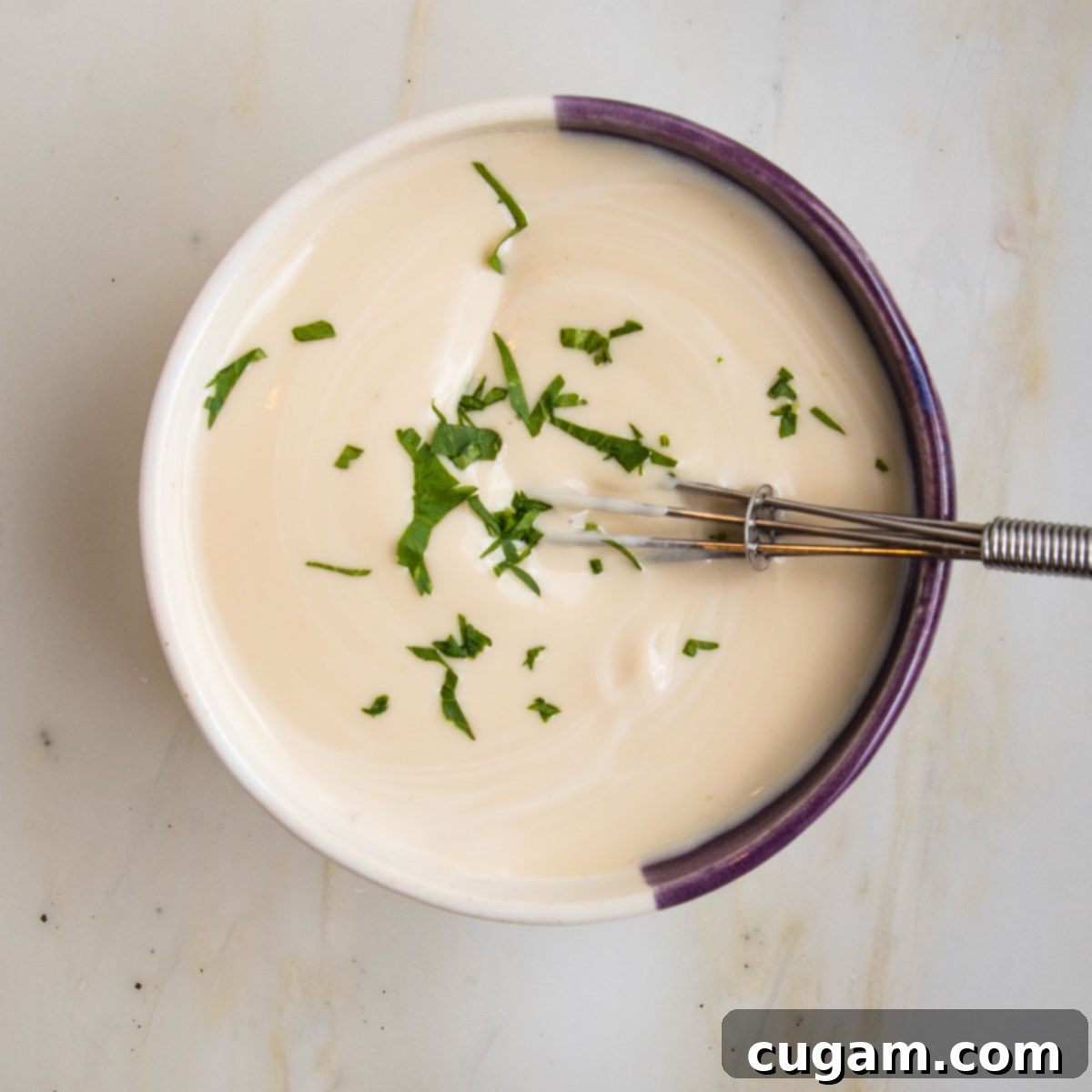
Simultaneously, prepare your tahini sauce. In a small bowl, whisk together the tahini, starting with just 2 tablespoons of water, and the maple syrup. Continue to add water, one tablespoon at a time, whisking vigorously after each addition, until you reach your desired drizzly consistency. The secret to a perfect, lump-free tahini sauce lies in using “drippy” tahini, which means thoroughly mixing the jar when you first open it to prevent separation into oily and hard portions. Finish with a sprinkle of chopped fresh herbs for added freshness and visual appeal. This sauce can also be made ahead and stored.
Enjoying Your Easy Baked Falafel
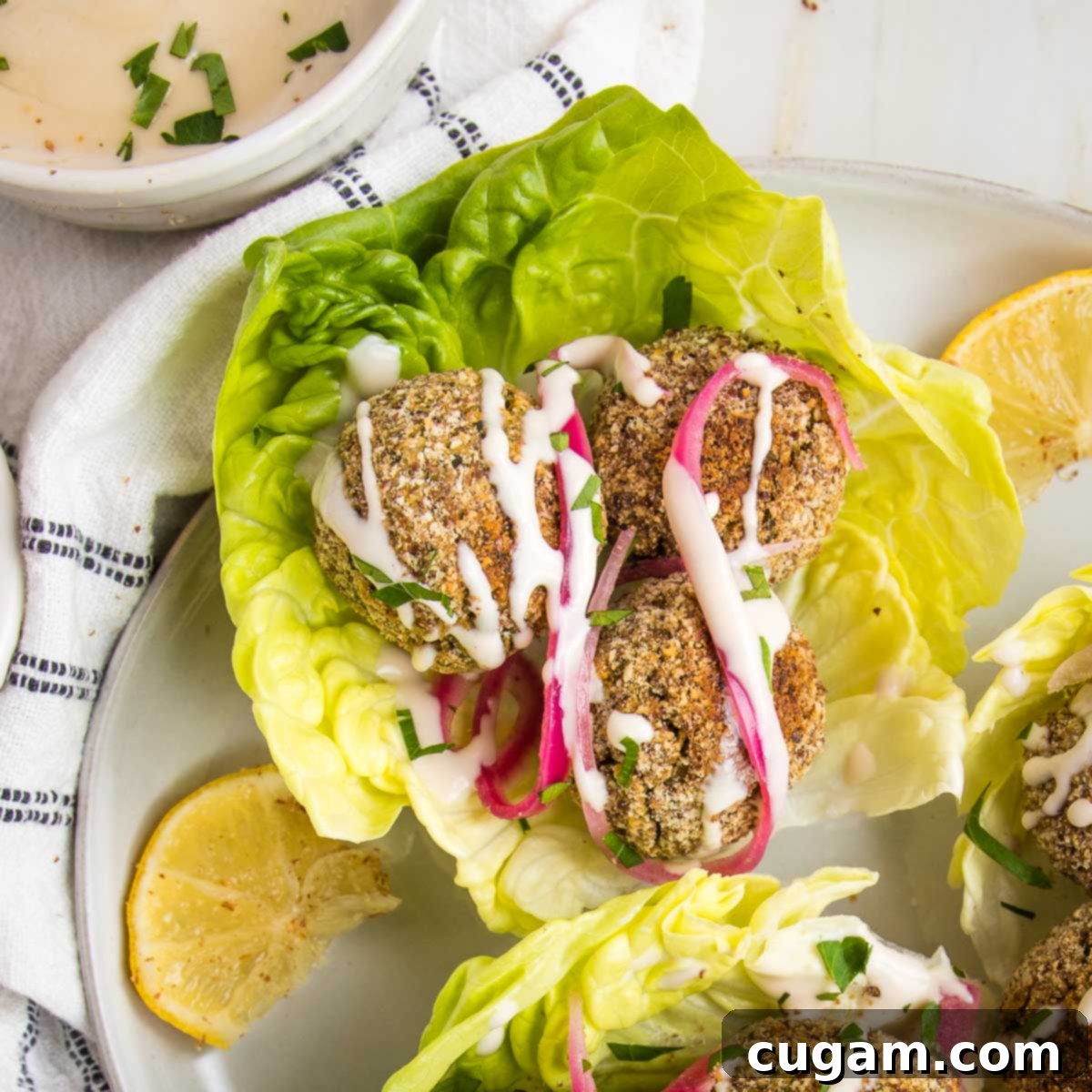
For a quick and effortless meal, grab a sturdy leaf of romaine or butter lettuce. Fill it with a few warm falafel balls, garnish generously with those tangy pickled onions, a squeeze of fresh lemon juice, and a luscious drizzle of your homemade tahini sauce. This is a wonderfully light yet satisfying way to enjoy your falafel. But don’t limit yourself! Use your imagination and whatever fresh ingredients you have on hand – perhaps even a spoonful of kimchi for a fusion twist – to get these delightful baked falafel into your belly!
Creative Ways to Serve Your Healthy Baked Falafel
These versatile baked falafel can be the star of countless meals. Here are some of my favorite ways to serve them, ensuring every dish is both flavorful and nourishing:
- The Classic Mediterranean Platter: Arrange your falafel on a large plate alongside a vibrant chopped Israeli salad, creamy traditional hummus (or a lighter roasted cauliflower hummus), smoky baba ganoush, a generous drizzle of tahini sauce, the bright pickled onions, and an assortment of briny olives. It’s a feast for the eyes and the palate.
- Perfect Wraps and Sandwiches: Create satisfying sandwiches with warm pita bread or light lettuce cups. Add shredded lettuce, a few slices of spicy jalapeños, some crunchy pickles, and a final drizzle of that irresistible tahini sauce. These are excellent for lunch or a quick dinner.
- A Hearty Plant-Based Protein Side: Serve your falafel as the main plant-based protein alongside traditional Mediterranean sides. Think fluffy Mediterranean cauliflower rice, beautifully charred grilled veggies, a refreshing ratatouille salad, or a crisp simple green salad. They perfectly complement a wide array of flavors.
- Falafel Bowls: Build a nutritious and customizable falafel bowl with a base of quinoa, couscous, or greens, then top with your falafel, roasted vegetables, fresh herbs, and plenty of sauce.
Debra’s Pro Tips for Falafel Success
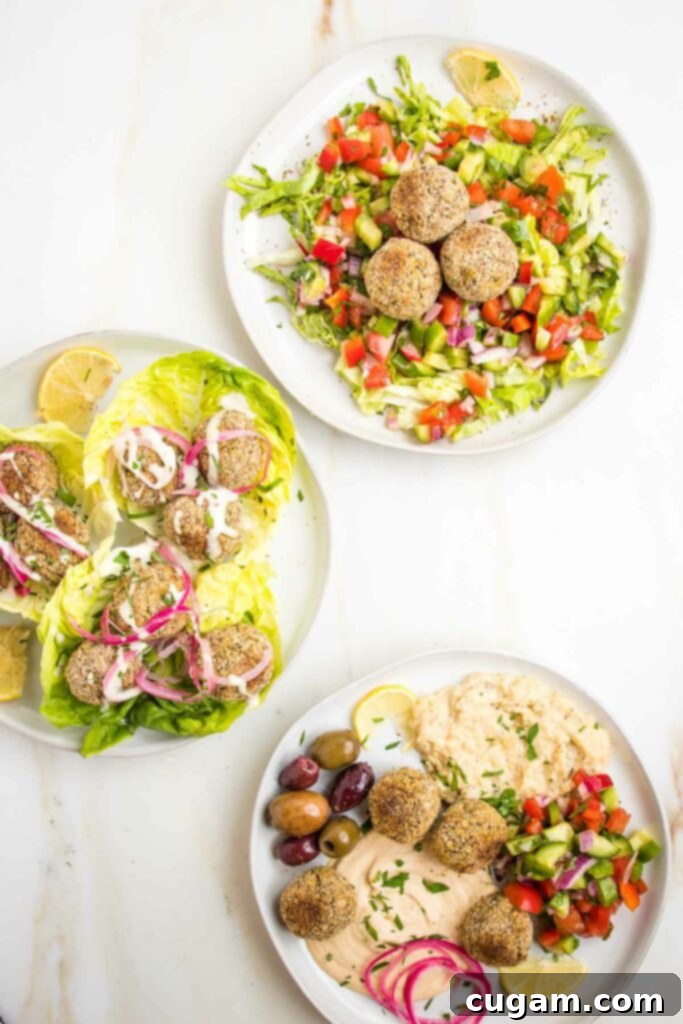
- Prepare Ahead: Pickled Onions: To save time on busy days, make the pickled onions in advance. Store the jar in the fridge, and they’ll be ready to add a tangy crunch whenever you need them. Their flavor only deepens over time!
- Advance Tahini Sauce Prep: If you prepare the tahini sauce ahead of time, allow it to come to room temperature before serving for the best pourable consistency. If it’s too thick, simply whisk in a tiny bit of warm water until it loosens up.
- Streamline Side Dishes: Divvy up your workload by preparing sides like roasted cauliflower hummus or baba ganoush a few days in advance. Alternatively, don’t hesitate to purchase high-quality pre-made versions – just be sure to read the labels for healthy choices.
- Canned vs. Dried Chickpeas: Use canned chickpeas for ultimate convenience and speed. If you prefer to save money and have more control over the texture, start with dried chickpeas. You can cook them quickly in your Instant Pot using a no-soak method, yielding perfectly firm chickpeas for your falafel.
- DIY Falafel Bar: For gatherings or family meals, set up a “falafel bar” with all the fixings: various greens, chopped veggies, different sauces, and pickles. This allows everyone to customize their own perfect bowl, plate, or wrap, making mealtime fun and interactive.
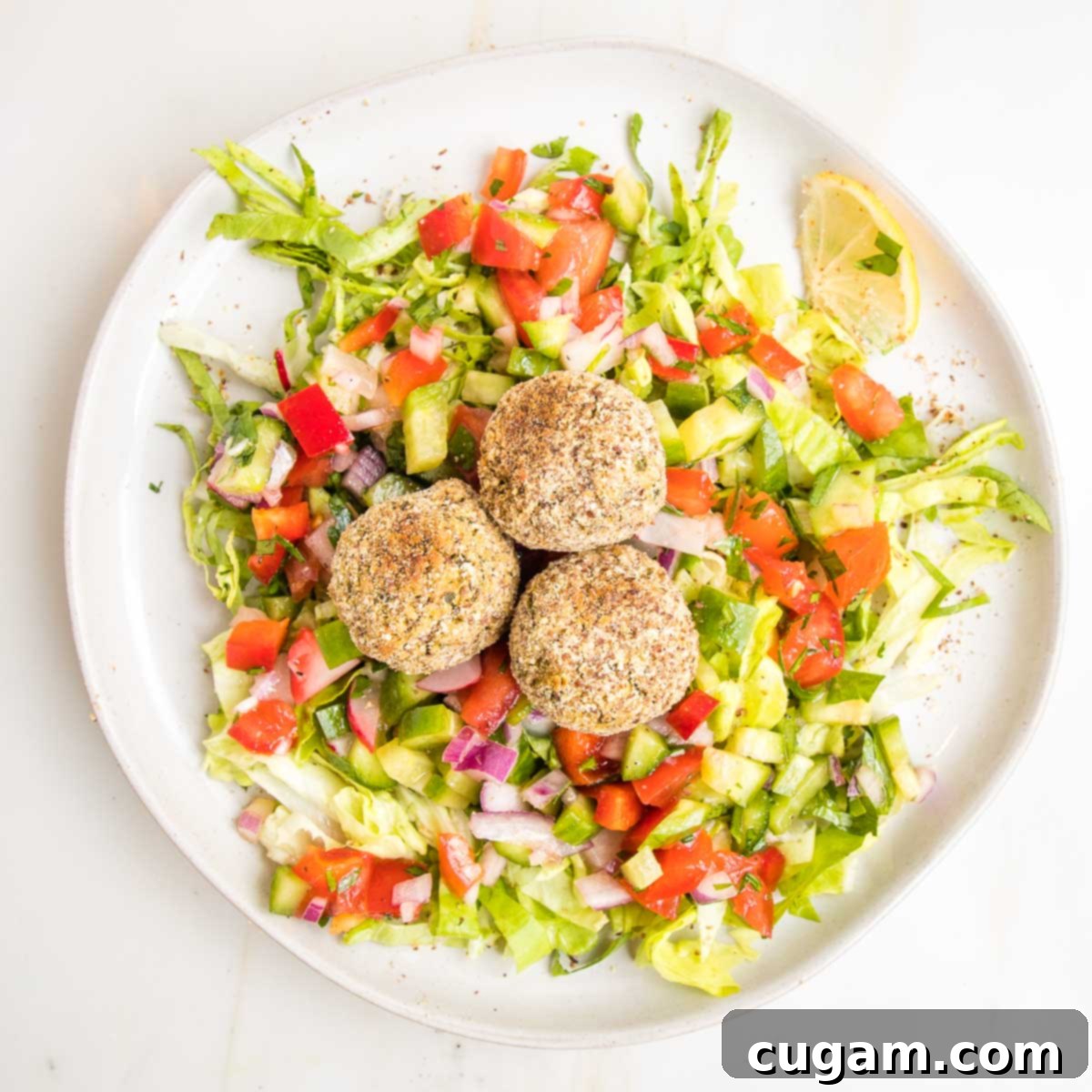
Meal Prep and Storage Tips for Baked Falafel
This recipe is incredibly meal-prep friendly, allowing you to enjoy fresh, delicious falafel throughout the week or even months!
- HOW TO SERVE: These versatile falafel can be served in pita or lettuce wraps with tahini drizzle and pickled onions (or a spicy kick of kimchi!), or as part of a vibrant salad plate with classic Mediterranean sides like olives, hummus, baba ganoush, or a refreshing Israeli chopped salad.
- PREP AHEAD: For maximum convenience, prepare the falafel mixture (before baking) and refrigerate it in an airtight container for up to 2-3 days, or freeze it for later use. This allows you to quickly bake fresh falafel whenever a craving strikes.
- STORE COOKED FALAFEL: Cooked falafel balls will stay fresh and delicious in an airtight container in the refrigerator for up to 5 days. They are great for quick lunches or snacks.
- FREEZE FOR LONGER STORAGE: To extend their life, freeze uncooked falafel balls for up to 3 months. Simply roll the mixture into balls, flash freeze them on a tray for at least 3 hours (until solid), then transfer them to freezer-safe zip-top bags. When ready to bake, you can often bake them directly from frozen, adding a few extra minutes to the baking time.
- REHEAT COOKED FALAFEL: To reheat cooked falafel, place them on a parchment-lined baking tray in a preheated 450°F (230°C) oven for about 10-15 minutes, or until thoroughly heated through and crispy again. Alternatively, you can pan-fry them in a heavy skillet over medium-high heat with a touch of oil for a few minutes per side until warmed and re-crisped.
Explore More Delicious Vegan Tahini Recipes
If you’ve fallen in love with tahini’s rich, nutty flavor, you’re in for a treat! This versatile ingredient isn’t just for savory dishes; it can add incredible depth to sweet treats and dressings too. Here are some more fantastic vegan tahini recipes to inspire your culinary adventures:
- Vegan Tahini Chocolate Chip Cookies (gluten-free)
- Creamy Tahini Caesar Dressing Recipe (vegan)
- Vegan Tahini Brownies
- Green Tahini Sauce
Did you know commenting and rating recipes is one of the best ways to support your favorite food bloggers? If you made this recipe, please consider giving it a five-star rating below and leaving a comment. Also, we’d love to see your culinary creations! Please share your photos on Instagram by tagging me @dkhealthcoach and using the hashtag #debraklein. Your support means the world!
📖 Recipe
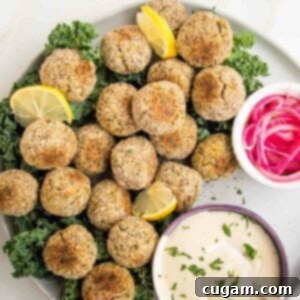
Healthy Baked Falafel
Debra Klein
Rate this Recipe
Pin Recipe
10 minutes
25 minutes
35 minutes
Main Course
Mediterranean
20
Falafel Balls
453
kcal
Equipment
-
16oz Wide Mouth Mason Jars
-
Small Cookie Scoop
-
Microplane
-
Citrus Squeezers
Ingredients
-
1 cup parsley -
1 cup cilantro -
½ cup raw sunflower seeds -
1 large shallot roughly chopped -
5 cloves garlic -
1 lemon zested and juiced -
1 Tablespoon cumin -
1 Tablespoon ground coriander -
½ teaspoon sea salt -
¼ teaspoon cayenne pepper* -
1 15-oz can chick. peas -
2 Tablespoons tahini -
¼ cup almond meal* -
¼ cup ground flax
Tahini drizzle:
-
¼ cup tahini -
¼ cup water -
2 teaspoons maple syrup
pickled onions
-
1 large purple onion thinly sliced -
½ cup cider vinegar -
½ cup white vinegar -
½ cup water -
2 Tablespoons maple syrup -
¼ tsp salt.
Instructions
Falafel:
-
Preheat oven to 450°F (230°C) and line a rimmed baking pan with unbleached parchment paper.
-
Place parsley, cilantro, sunflower seeds, shallot, and garlic into the bowl of a food processor. Process until everything is well chopped into tiny, uniform pieces.
-
Zest the lemon over the processor bowl, then sprinkle in the cumin, coriander, salt, and cayenne pepper. Process again until spices are well mixed.
-
Juice the lemon over the mixture, then add the chickpeas and tahini. Pulse until the mixture forms a coarse paste that holds together, with a few small chunks remaining.
-
In a shallow bowl, mix together the almond meal and ground flaxseed for the coating.
-
Use a small cookie scoop to portion out about 20 falafel onto the prepared pan. Wet your hands and roll each portion into a golf-ball-sized sphere. Drop each ball into the flax/almond mixture, toss to coat evenly, then place back on the prepared pan.
-
Bake for 15 minutes, then gently turn the falafel balls to the other side and bake for an additional 10 minutes, or until golden brown and crispy.
-
Store any extra falafel balls in an airtight container in the fridge for up to a week. Leftovers can be enjoyed cold or at room temperature. For warm falafel, gently reheat them on the stovetop or in a 375°F (190°C) oven until heated through.
Tahini Drizzle:
-
In a small bowl, whisk together the tahini, maple syrup, and an initial 2 tablespoons of water. Continue adding water, one tablespoon at a time, whisking well after each addition, until you achieve a smooth, pourable consistency.
-
Store the tahini drizzle in an airtight container in the fridge for up to 2 weeks. If it hardens or thickens, set the container in a bath of warm water and whisk, or simply whisk in 1 tablespoon of warm water until smooth again.
Pickled Onion
-
Thinly slice the purple onion and place the slices into a small glass jar.
-
In a small saucepan, combine the cider vinegar, white vinegar, water, maple syrup, and salt. Bring the mixture to a boil, then reduce the heat to a simmer. Stir continuously until the maple syrup and salt are completely dissolved.
-
Pour the hot pickling liquid over the sliced onions in the jar, ensuring they are all fully submerged. Let the jar sit at room temperature until the onions cool and are ready to serve.
-
Store the sealed jar of pickled onions in the fridge for up to 2 weeks.
Notes
ALMOND MEAL: For those with nut allergies or preferences, simply dust the falafel balls with all ground flaxseed or another suitable nut-free mixture you can safely enjoy.
OPTIONAL WRAPS: Get creative with your wraps! Beyond pita, consider crisp butter lettuce leaves, sturdy cabbage leaves, nutrient-rich collard greens, or even vibrant Swiss chard for a low-carb alternative.
OPTIONAL FILLINGS: Enhance your falafel experience with additional fillings like sliced jalapeños for a kick, fresh chopped cucumbers and tomatoes for crunch, an extra squeeze of lemon juice, thinly sliced cabbage, briny olives, various chopped greens, or a medley of fresh herbs.
FALAFEL SALAD PLATE: For a complete and satisfying meal, serve your baked falafel balls alongside a generous dollop of cauliflower hummus, smoky baba ganoush, the tangy pickled onions, a fresh Israeli salad, and an assortment of your favorite olives.
Nutrition
Serving:
5
falafel balls
Calories:
453
kcal
Carbohydrates:
34
g
Protein:
15
g
Fat:
28
g
Saturated Fat:
3
g
Polyunsaturated Fat:
23
g
Sodium:
605
mg
Fiber:
11
g
Sugar:
14
g
Note
The nutrition calculations were done using online tools. To obtain the most accurate representation of the nutritional information in any given recipe, you should calculate the nutritional information with the actual ingredients you used. You are ultimately responsible for ensuring that any nutritional information is accurate, complete and useful.
Did you make this recipe?
Please leave a review below, then snap a picture and tag me @dkhealthcoach or use hashtag #dkhealtcoach on Instagram so I can see it!!
